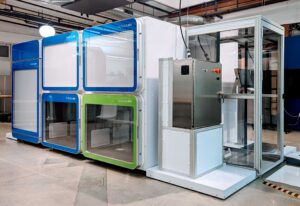A novel approach to automating cell therapy manufacturing using industry-standard equipment can potentially reduce human errors, deliver higher quality product, and lower manufacturing costs by approximately 70 percent.
This robotic technique, developed by Multiply Labs, automates cell therapy manufacturing equipment, and can accommodate new equipment as instruments and processes evolve. Because Multiply Labs’ approach is vendor agnostic, manufacturers can simply add this layer of automation atop their existing processes. Therefore, there is no need to redesign the manufacturing process to fit the equipment, which sometimes occurs with proprietary automation systems.
“Our approach is not to design instruments, consumables, or reagents,” Fred Parietti, PhD, co-founder and CEO of Multiply Labs, tells GEN. “Our approach teaches robots to use the good manufacturing process (GMP)-proven instruments and consumable reagents that people already are using so their process stays substantially the same but automated.”
To do this, Multiply Labs partners with leaders in the biopharma equipment space, including GenScript, Cytiva, Thermo Fisher, Charles River Laboratories, Akron Bio, and Fedegari, among others.
Cell and gene therapy manufacturing, today, is largely artisanal. “It reminds me of mechanical, hand-crafted watches,” Parietti says. That’s why manufacturing a cell or gene therapy product costs a rough average of $100,000 to $300,000 per dose. When those costs are combined with the high costs of research and development, drug prices soar into the million-plus dollar range.
Labor accounts for about half the manufacturing costs, Parietti says. “Automating cell and gene therapy doesn’t eliminate jobs,” he points out. “Supervising scientists are still needed; they’re just not pipetting now.” Automation removes the mundane tasks and those which are most likely to contaminate processes.
How Robotics Improve Processes
Writing in Cytotherapy, Parietti, co-senior author Jonathan Esensten, MD, PhD, associate adjunct professor, University of California San Francisco (UCSF), and their team cultured CD8+ T cells, comparing standard, manual cell expansion manufacturing process to a process using the same instruments, but operated by robotic systems. Both the manual process and the automated one used the following GMP-proven instruments: the Thermo Scientific™ Heracell™ VIOS incubator, the Wilson Wolf G-Rex bioreactor, and the Cytiva Xuri bioreactor.
The scientists noted that although the quality of automated and manual versions was statistically comparable, the standard deviation was lower for the robotic process. “The range of variation was much narrower, (increasing) robustness and repeatability,” Parietti says. “We also saw a decrease in actual errors in the automated culture,” he adds. “The tests were performed by PhDs at UCSF, so this was not a matter of (a lack of) skill.”

Resuspension is another example. “We learned that every scientist has their own way of swirling the culture flask, and some obtain higher yields than others. When a pharma company visits, I tell them, ‘I need your highest-yield scientist, and I know you have one.’ Everyone laughs because everyone knows that person’s name,” he says. Multiply Labs records the motion that the scientist uses and replicates it with the robots. “From that point on, you’re guaranteed that only that trajectory will be executed by the robot.”
Notably, the Thermo Scientific™ VIOS Automated Access CO2 Incubator can support 18 products at once per incubator. In contrast, manual manufacturing typically supports one, and competitors’ systems support up to 16, he says. Automation also shrinks the necessary production space to 400 to 500 square feet, down from the 1,000 to 2000 square feet needed for human-operated workflows.
Transitioning to robotics
One of the challenges reported in the Cytotherapy paper was the need for customized cartridges. Because robots can’t easily manipulate soft and unstructured objects, Multiply Labs repackaged the consumable sets of bags and tubes into a rigid cartridge. This “allow(s) the robotic arm to connect tubes, transfer liquids in and out of bags, and move bioreactors that were originally designed for human hands,” the scientists wrote. Now, Parietti says, “All the robot needs to do is pick up the cartridge and put it on top of the instrument, and it clicks in.” Cartridges are available from the instrument’s manufacturer.
To transition to robotic cell and gene manufacturing, biomanufacturers first should “review their processes and ensure we have automated the instruments they’re using,” Parietti says. He estimates the company has automated 70-80 percent of the major processing instruments used for cell and gene manufacturing and says he expects to automate several more during the next few months.
“Our goal is not to automate every possible instrument,” Parietti says, but to concentrate on the leading instruments for GMP manufacturing. “We take a modular approach with our robots so you can add or swap out modules.”


